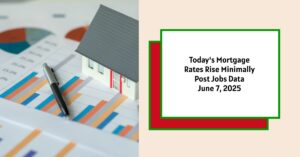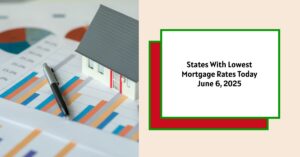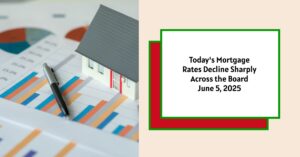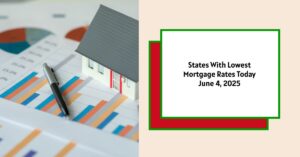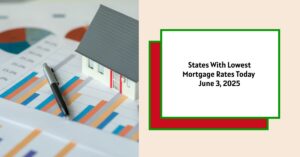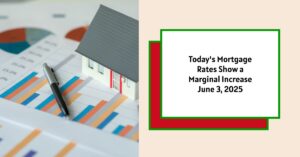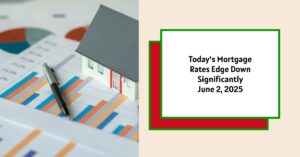As of June 7, 2025, the national average 30-year fixed mortgage rate is currently at 7.04%, reflecting a slight increase from the previous week’s rate of 7.01%. According to Zillow, the 15-year fixed mortgage rate has also seen a modest rise to 6.15% from 6.12%, while the 5-year ARM mortgage rate has slightly decreased to 7.78% from 7.79%.
Today's Mortgage Rates – June 7, 2025: Rates Rise Minimally Post Jobs Data
Key Takeaways
- 30-Year Fixed Rate: 7.04% as of June 7, showing minimal upward movement.
- 15-Year Fixed Rate: Increased to 6.15% from last week.
- 5-Year ARM: Decreased to 7.78%.
- Refinance Rates: 30-year refinance rates average 7.31%.
- Market Trends: Job reports and rising bond yields are affecting mortgage rates.
Mortgage rates are an essential factor for anyone considering buying a home or refinancing an existing mortgage. They can have a significant impact on monthly payments, overall loan costs, and the housing market's vibrancy. Understanding the context behind these rates can help you make more informed decisions.
Current Mortgage Rates Overview
To better understand the current landscape, let's look at the updated mortgage rates from Zillow for various loan types, both for purchasing and refinancing.
Mortgage Rates Table
| Loan Type | Current Rate | 1W Change (%) | APR | 1W Change (%) |
|---|---|---|---|---|
| 30-Year Fixed Rate | 7.04% | +0.03% | 7.52% | +0.05% |
| 20-Year Fixed Rate | 6.83% | -0.14% | 7.35% | -0.04% |
| 15-Year Fixed Rate | 6.15% | +0.09% | 6.47% | +0.11% |
| 10-Year Fixed Rate | 5.97% | -0.10% | 6.05% | -0.42% |
| 7-Year ARM | 7.56% | +0.01% | 8.07% | +0.15% |
| 5-Year ARM | 7.78% | +0.24% | 8.08% | +0.12% |
| 3-Year ARM | – | – | – | – |
Refinancing Rates Table
| Loan Type | Current Rate | 1W Change (%) | APR | 1W Change (%) |
|---|---|---|---|---|
| 30-Year Fixed Rate | 7.31% | +0.05% | 7.52% | +0.05% |
| 20-Year Fixed Rate | 6.83% | -0.14% | 7.35% | -0.04% |
| 15-Year Fixed Rate | 6.22% | +0.10% | 6.47% | +0.11% |
| 10-Year Fixed Rate | 5.97% | -0.10% | 6.05% | -0.42% |
| 7-Year ARM | 7.56% | +0.01% | 8.07% | +0.15% |
| 5-Year ARM | 8.06% | +0.02% | 8.08% | +0.12% |
Analyzing the Current Economic Situation
Several factors are impacting mortgage rates on June 7, 2025. A robust jobs report rating has led to a more favorable economic outlook, which, combined with rising bond market yields, typically resets the mortgage landscape. Currently, the yield on the 10-year Treasury has risen over 2.5%, which has historically indicated higher mortgage rates.
According to Zillow, the national average 30-year fixed mortgage rate climbed 2 basis points from 7.02% to 7.04%, representing a 3 basis point increase from the previous week’s average of 7.01%.
The Impact of Economic Trends on Mortgage Rates
Understanding the dynamics of the employment sector and the bond market plays a crucial role in predicting mortgage rates. This June, the labor market has shown strength with job gains, and this positive momentum increases consumer confidence, often leading to more home purchases. As demand for mortgages increases, lenders can afford to raise rates.
Bond Yields and Their Relation to Mortgage Rates
Mortgage rates often correlate with bond yields, particularly the 10-year Treasury yield. When bond prices rise, yields fall, leading to lower mortgage rates and vice versa. In recent weeks, as jobs reports have come in strong, investors shifted capital towards equities, pushing bond prices down and yields up. This upward trend in yields has contributed to the rise in mortgage rates.
It's essential to note that while current rates are on the higher end compared to some past years, they are seen as relatively stable within the economic context. Lenders are adjusting their rates based on market demands, but fluctuations have remained controlled relative to the volatility seen in previous years.
Mortgage Rate Projections
Looking ahead, many analysts expect mortgage rates to remain steady through the year, albeit at levels that might not be as desirable as prospective buyers would hope for. Here are some key insights based on predictions from various institutions regarding future mortgage rates:
- Freddie Mac projects that mortgage rates will remain higher than anticipated for the foreseeable future, affecting potential buyers and sellers who may feel the pressure to step into the market early, given that rates are not expected to decline significantly anytime soon (source).
- Fannie Mae also expects a modest reduction, predicting that rates may edge down to about 6.1% by the end of 2025 (source).
- The National Association of Realtors has a similarly cautious outlook, projecting mortgage rates to average around 6.4% through 2025.
Detailed Analysis of Loan Types
Conforming Loans
Conforming loans are a popular choice among buyers, as they meet the requirements set by Fannie Mae and Freddie Mac. As shown in the mortgage rates table, the 30-year fixed-rate loan currently sits at 7.04%, which is slightly higher than rates seen in the previous weeks.
A 20-year fixed-rate mortgage provides a middle ground between the stability of fixed rates and lower overall interest payments compared to a longer-term loan. This rate currently stands at 6.83%.
Fixed vs. Adjustable-Rate Mortgages (ARMs)
For those considering more flexibility in their mortgage plans, Adjustable-Rate Mortgages (ARMs) might be appealing. The 5-year ARM currently reflects a rate of 7.78%, providing significantly different options for buyers to explore variable rates after the initial fixed period.
Government Loans
Government-backed loans usually present favorable terms for first-time homebuyers or those with lower credit scores. FHA and VA loans are prominent in this category. Here are some key current rates:
- 30-Year Fixed Rate FHA Loan: 7.75%
- 30-Year Fixed Rate VA Loan: 6.56%
These loans are designed to make homeownership more accessible to eligible buyers. FHA loans, with their lower down payment requirements, can be particularly attractive to those entering the housing market.
Read More:
Mortgage Rates Trends as of June 6, 2025
Mortgage Rate Predictions for June 2025: Will Rates Go Down?
Refinancing Trends and Home Buying Dynamics
Given the higher mortgage rates, many existing homeowners might consider refinancing their mortgages. Today, the national average 30-year fixed refinance rate stands at 7.31%, up 5 basis points from 7.26% last week. Here are the key points regarding the current refinance market:
- The average 15-year fixed refinance rate is up to 6.22% from 6.12%.
- The 5-year ARM refinance rate is also seeing an increase, arriving at 8.06%.
This indicates a trend that might push some homeowners to refinance rather than purchasing a new home if they currently possess a lower mortgage rate. It’s essential for homeowners to weigh the benefits of refinancing against the current rates before making decisions.
Final Thoughts on the 2025 Market Dynamics
As we progress through 2025, various external factors will continue to play a significant role in shaping the mortgage landscape. Ongoing geopolitical events, currency fluctuations, and inflation remain key components to monitor.
The Mortgage Bankers Association has forecasted a near-future where 30-year rates hover around 6.7% through September, suggesting that although there may be marginal bumps in rates based on market conditions, no significant declines are anticipated in the immediate future.
Overall, mortgage rates on June 7, 2025 are slightly increasing, but rates are expected to stabilize as the market adjusts to ongoing economic conditions. Whether you are considering purchasing a home or refinancing, monitoring these rates closely can help you make a more informed decision.
Invest Smarter in a High-Rate Environment
With mortgage rates remaining elevated this year, it's more important than ever to focus on cash-flowing investment properties in strong rental markets.
Norada helps investors like you identify turnkey real estate deals that deliver predictable returns—even when borrowing costs are high.
HOT NEW LISTINGS JUST ADDED!
Connect with a Norada investment counselor today (No Obligation):
(800) 611-3060
Also Read:
- Will Mortgage Rates Go Down in 2025: Morgan Stanley's Forecast
- Expect High Mortgage Rates Until 2026: Fannie Mae's 2-Year Forecast
- Mortgage Rate Predictions 2025 from 4 Leading Housing Experts
- Mortgage Rates Forecast for the Next 3 Years: 2025 to 2027
- 30-Year Mortgage Rate Forecast for the Next 5 Years
- 15-Year Mortgage Rate Forecast for the Next 5 Years
- Why Are Mortgage Rates Going Up in 2025: Will Rates Drop?
- Why Are Mortgage Rates So High and Predictions for 2025
- Will Mortgage Rates Ever Be 3% Again in the Future?
- Mortgage Rates Predictions for Next 2 Years
- Mortgage Rate Predictions for Next 5 Years
- Mortgage Rate Predictions: Why 2% and 3% Rates are Out of Reach
- How Lower Mortgage Rates Can Save You Thousands?
- How to Get a Low Mortgage Interest Rate?
- Will Mortgage Rates Ever Be 4% Again?
